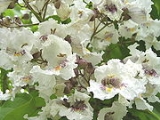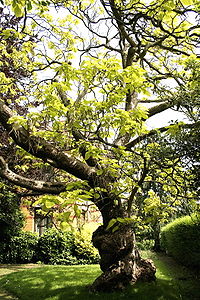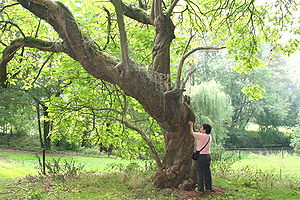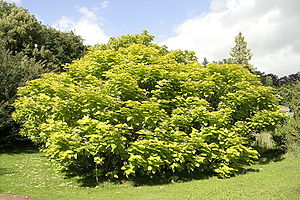
Southern Catalpa
Encyclopedia
Catalpa bignonioides is a species of Catalpa
that is native to the southeastern United States
in Alabama
, Florida
, Georgia
, Louisiana
, and Mississippi
. Common names include Southern Catalpa, Cigartree, and Indian Bean Tree.
tree
growing to 15-18 meters tall, with a trunk up to 1 m diameter with brown to gray bark
, maturing into hard plates or ridges. The short thick trunk supports long and straggling branches which form a broad and irregular head. The roots are fibrous and branches are brittle. Its juices are watery and bitter.
The leaves
are large and heart shaped, being 20-30 cm long and 15-20 cm broad. The bright green leaves appear late and as they are full grown before the flower clusters open, add much to the beauty of the blossoming tree. They secrete nectar, a most unusual characteristic for leaves, by means of groups of tiny glands in the axils of the primary veins.
 The flower
The flower
s are 2.5-4 cm across, trumpet shaped, white with yellow spots inside; they grow in panicle
s of 20-40. In the northern states of the USA, it is a late bloomer, putting forth great panicles of white flowers in June or early in July when the flowers of other trees have mostly faded. These cover the tree so thickly as almost to conceal the full grown leaves. The general effect of the flower cluster is a pure white, but the individual corolla is spotted with purple and gold, and some of these spots are arranged in lines along a ridge, so as to lead directly to the honey sweets within. A single flower when fully expanded is two inches long and an inch and a half wide. It is two-lipped and the lips are lobed, two lobes above and three below, as is not uncommon with such corollas. The flower is perfect, possessing both stamens and pistils; nevertheless, the law of elimination is at work and of the five stamens that we should expect to find, three have aborted, ceased to bear anthers and have become filaments simply. Then, too, the flowers refuse to be self-fertilized. Each flower has its own stamens and its own stigma but the lobes of the stigma remain closed until after the anthers have opened and discharged their pollen; after they have withered and become effete then the stigma opens and invites the wandering bee. The entire Pink family behave in this way.
 The fruit
The fruit
is a long, thin bean like pod 20-40 cm long and 8-10 mm diameter; it often stays attached to tree during winter. The pod contains numerous flat light brown seeds with two papery wings.
It is closely related to the Northern Catalpa (C. speciosa), and can be distinguished by the flowering panicles, which bear a larger number of smaller flowers, and the slightly slenderer seed pods.

Native American tribes, who called it Catalpa. However, it can flourish in the North as well, and accordingly its original range is somewhat in doubt.
Despite its southern origins, it has been able to grow almost anywhere in the United States and southernmost Canada, and has become widely naturalized
outside its restricted native range.
countries.
It prefers moist soil and full sun. It is easily raised from seeds which germinate early in the first season. It also multiplies readily from cuttings. The tree is fairly free from fungal diseases and has few insect enemies.
The wood
is brittle and hard, but does not rot easily; it is used for fence posts and railroad ties.
and its fossil
remains have been discovered in the Miocene rocks
of the Yellowstone River
.
Catalpa
Catalpa, commonly called catalpa or catawba, is a genus of flowering plants in the trumpet vine family, Bignoniaceae, native to warm temperate regions of North America, the Caribbean, and East Asia....
that is native to the southeastern United States
Southeastern United States
The Southeastern United States, colloquially referred to as the Southeast, is the eastern portion of the Southern United States. It is one of the most populous regions in the United States of America....
in Alabama
Alabama
Alabama is a state located in the southeastern region of the United States. It is bordered by Tennessee to the north, Georgia to the east, Florida and the Gulf of Mexico to the south, and Mississippi to the west. Alabama ranks 30th in total land area and ranks second in the size of its inland...
, Florida
Florida
Florida is a state in the southeastern United States, located on the nation's Atlantic and Gulf coasts. It is bordered to the west by the Gulf of Mexico, to the north by Alabama and Georgia and to the east by the Atlantic Ocean. With a population of 18,801,310 as measured by the 2010 census, it...
, Georgia
Georgia (U.S. state)
Georgia is a state located in the southeastern United States. It was established in 1732, the last of the original Thirteen Colonies. The state is named after King George II of Great Britain. Georgia was the fourth state to ratify the United States Constitution, on January 2, 1788...
, Louisiana
Louisiana
Louisiana is a state located in the southern region of the United States of America. Its capital is Baton Rouge and largest city is New Orleans. Louisiana is the only state in the U.S. with political subdivisions termed parishes, which are local governments equivalent to counties...
, and Mississippi
Mississippi
Mississippi is a U.S. state located in the Southern United States. Jackson is the state capital and largest city. The name of the state derives from the Mississippi River, which flows along its western boundary, whose name comes from the Ojibwe word misi-ziibi...
. Common names include Southern Catalpa, Cigartree, and Indian Bean Tree.
Description
It is a medium-sized deciduousDeciduous
Deciduous means "falling off at maturity" or "tending to fall off", and is typically used in reference to trees or shrubs that lose their leaves seasonally, and to the shedding of other plant structures such as petals after flowering or fruit when ripe...
tree
Tree
A tree is a perennial woody plant. It is most often defined as a woody plant that has many secondary branches supported clear of the ground on a single main stem or trunk with clear apical dominance. A minimum height specification at maturity is cited by some authors, varying from 3 m to...
growing to 15-18 meters tall, with a trunk up to 1 m diameter with brown to gray bark
Bark
Bark is the outermost layers of stems and roots of woody plants. Plants with bark include trees, woody vines and shrubs. Bark refers to all the tissues outside of the vascular cambium and is a nontechnical term. It overlays the wood and consists of the inner bark and the outer bark. The inner...
, maturing into hard plates or ridges. The short thick trunk supports long and straggling branches which form a broad and irregular head. The roots are fibrous and branches are brittle. Its juices are watery and bitter.
The leaves
Leaf
A leaf is an organ of a vascular plant, as defined in botanical terms, and in particular in plant morphology. Foliage is a mass noun that refers to leaves as a feature of plants....
are large and heart shaped, being 20-30 cm long and 15-20 cm broad. The bright green leaves appear late and as they are full grown before the flower clusters open, add much to the beauty of the blossoming tree. They secrete nectar, a most unusual characteristic for leaves, by means of groups of tiny glands in the axils of the primary veins.

Flower
A flower, sometimes known as a bloom or blossom, is the reproductive structure found in flowering plants . The biological function of a flower is to effect reproduction, usually by providing a mechanism for the union of sperm with eggs...
s are 2.5-4 cm across, trumpet shaped, white with yellow spots inside; they grow in panicle
Panicle
A panicle is a compound raceme, a loose, much-branched indeterminate inflorescence with pedicellate flowers attached along the secondary branches; in other words, a branched cluster of flowers in which the branches are racemes....
s of 20-40. In the northern states of the USA, it is a late bloomer, putting forth great panicles of white flowers in June or early in July when the flowers of other trees have mostly faded. These cover the tree so thickly as almost to conceal the full grown leaves. The general effect of the flower cluster is a pure white, but the individual corolla is spotted with purple and gold, and some of these spots are arranged in lines along a ridge, so as to lead directly to the honey sweets within. A single flower when fully expanded is two inches long and an inch and a half wide. It is two-lipped and the lips are lobed, two lobes above and three below, as is not uncommon with such corollas. The flower is perfect, possessing both stamens and pistils; nevertheless, the law of elimination is at work and of the five stamens that we should expect to find, three have aborted, ceased to bear anthers and have become filaments simply. Then, too, the flowers refuse to be self-fertilized. Each flower has its own stamens and its own stigma but the lobes of the stigma remain closed until after the anthers have opened and discharged their pollen; after they have withered and become effete then the stigma opens and invites the wandering bee. The entire Pink family behave in this way.

Fruit
In broad terms, a fruit is a structure of a plant that contains its seeds.The term has different meanings dependent on context. In non-technical usage, such as food preparation, fruit normally means the fleshy seed-associated structures of certain plants that are sweet and edible in the raw state,...
is a long, thin bean like pod 20-40 cm long and 8-10 mm diameter; it often stays attached to tree during winter. The pod contains numerous flat light brown seeds with two papery wings.
It is closely related to the Northern Catalpa (C. speciosa), and can be distinguished by the flowering panicles, which bear a larger number of smaller flowers, and the slightly slenderer seed pods.
- Bark: Light brown tinged with red. Branchlets forking regularly by pairs, at first green, shaded with purple and slightly hairy, later gray or yellowish brown, finally reddish brown. Contains tannin.
- Wood: Light brown, sapwood nearly white; light, soft, coarse-grained and durable in contact with the soil.
- Winter buds: No terminal bud, uppermost bud is axillary. Minute, globular, deep in the bark. Outer scales fall when spring growth begins, inner scales enlarge with the growing shoot, become green, hairy and sometimes two inches long.
- Leaves: Opposite, or in threes, simple, six to ten inches long, four to five broad. Broadly ovate, cordate at base, entire, sometimes wavy, acute or acuminate. Feather-veined, midrib and primary veins prominent. Clusters of dark glands, which secrete nectar are found in the axils of the primary veins. They come out of the bud involute, purplish, when full grown are bright green, smooth above, pale green, and downy beneath. When bruised they give a disagreeable odor. They turn dark and fall after the first severe frost. Petioles stout, terete, long.
- Flowers: June, July. Perfect, white, borne in many-flowered thyrsoid panicles, eight to ten inches long. Pedicels slender, downy.
- Calyx: Globular and pointed in the bud; finally splitting into two, broadly ovate, entire lobes, green or light purple.
- Corolla: Campanulate, tube swollen, slightly oblique, two-lipped, five-lobed, the two lobes above smaller than the three below, imbricate in bud; limb spreading, undulate, when fully expanded is an inch and a half wide and nearly two inches long, white, marked on the inner surface with two rows of yellow blotches and in the throat on the lower lobes with purple spots.
- Stamens: Two, rarely four, inserted near the base of the corolla, introrse, slightly exserted; anthers oblong, two-celled, opening longitudinally; filaments flattened, thread-like. Sterile filaments three, inserted near base of corolla, often rudimentary.
- Pistil: Ovary superior, two-celled; style long, thread-like, with a two-lipped stigma. Ovules numerous.
- Fruit: Long slender capsule, nearly cylindrical, two-celled, partition at right angles to the valves. Six to twenty inches long, brown; hangs on the tree all winter, splitting before it falls. Seeds an inch long, one-fourth of an inch wide, silvery gray, winged on each side and ends of wings fringed.

Distribution
In the USA, Catalpa bignonioides is undoubtedly a Southern tree. Europeans first observed the tree growing in the fields of the CherokeeCherokee
The Cherokee are a Native American people historically settled in the Southeastern United States . Linguistically, they are part of the Iroquoian language family...
Native American tribes, who called it Catalpa. However, it can flourish in the North as well, and accordingly its original range is somewhat in doubt.
Despite its southern origins, it has been able to grow almost anywhere in the United States and southernmost Canada, and has become widely naturalized
Naturalisation (biology)
In biology, naturalisation is any process by which a non-native organism spreads into the wild and its reproduction is sufficient to maintain its population. Such populations are said to be naturalised....
outside its restricted native range.
Cultivation and uses
It is widely grown as an ornamental tree. The Catalpa has the distinction of bearing some of the showiest flowers of all the American native trees. Its value in this respect has long been recognized and it holds an assured place in the parks and gardens of all temperateTemperate
In geography, temperate or tepid latitudes of the globe lie between the tropics and the polar circles. The changes in these regions between summer and winter are generally relatively moderate, rather than extreme hot or cold...
countries.
It prefers moist soil and full sun. It is easily raised from seeds which germinate early in the first season. It also multiplies readily from cuttings. The tree is fairly free from fungal diseases and has few insect enemies.
The wood
Wood
Wood is a hard, fibrous tissue found in many trees. It has been used for hundreds of thousands of years for both fuel and as a construction material. It is an organic material, a natural composite of cellulose fibers embedded in a matrix of lignin which resists compression...
is brittle and hard, but does not rot easily; it is used for fence posts and railroad ties.
History
The genus was common in Europe during the Tertiary periodTertiary
The Tertiary is a deprecated term for a geologic period 65 million to 2.6 million years ago. The Tertiary covered the time span between the superseded Secondary period and the Quaternary...
and its fossil
Fossil
Fossils are the preserved remains or traces of animals , plants, and other organisms from the remote past...
remains have been discovered in the Miocene rocks
Miocene
The Miocene is a geological epoch of the Neogene Period and extends from about . The Miocene was named by Sir Charles Lyell. Its name comes from the Greek words and and means "less recent" because it has 18% fewer modern sea invertebrates than the Pliocene. The Miocene follows the Oligocene...
of the Yellowstone River
Yellowstone River
The Yellowstone River is a tributary of the Missouri River, approximately long, in the western United States. Considered the principal tributary of the upper Missouri, the river and its tributaries drain a wide area stretching from the Rocky Mountains in the vicinity of the Yellowstone National...
.

